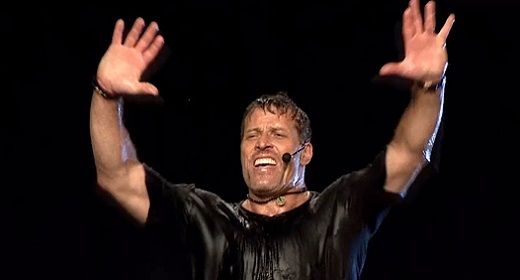by Tony Robbins: The practice of meditation has been around for thousands of years…
Today, meditation is growing in popularity among business owners and others in high-stress positions, given meditation’s ability to relieve stress, heal the body and harmonize the mind, body and emotions. If you are considering starting a meditation practice, you need simple but effective meditation techniques that you can feasibly do on a daily basis. The good news is that meditation exercises are actually very practical, and many of them can be performed any time, even on the go. Learn to take control of your mind and emotions using these simple strategies.
MEDITATION TECHNIQUES FOR THE MIND, BODY AND EMOTIONS
When it comes to learning to meditate, there is no one-size-fits-all, so select the meditation exercises that work best for you.
LOVING-KINDNESS MEDITATION EXERCISES
Are you experiencing a situation or relationship that is causing stress or frustration? Consider loving-kindness meditation, also known as “metta” meditation. This type of meditation utilizes breathing exercises coupled with mental mantras. In combination, these meditation techniques cultivate a greater awareness of one’s sense of self-love as well as kindness toward others, including negative or difficult experiences. Interestingly, research suggests that cultivating kindness is actually a precursor to finding greater fulfillment in one’s relationships. So, since loving-kindness meditation entails both individual and relational aspects, it is one of the most effective meditation techniques for cultivating lasting happiness in one’s relationships. And, as Tony Robbins says, nurturing fulfilling relationships is an essential component of the human experience.


Practicing loving-kindness meditation exercises only takes about 15 minutes per day. Sit somewhere quiet where you can relax. Breathe deeply, focusing on each breath. As you inhale, imagine that you are breathing in loving-kindness toward yourself and repeat a self-affirming mantra, like “I am loveable” or “I am worthy of happiness.” Then, as you exhale, imagine that you are sending messages of loving-kindness to the people or circumstances in your life. For example, you might try “I extend my love and kindness to you.” You might try starting with something simple, like a person or situation that brings you joy, before moving on to more problematic people or circumstances. With practice, loving-kindness meditation exercises become easier, and you will begin to experience results.
PROGRESSIVE RELAXATION MEDITATION TECHNIQUES
If you are having a hard time relaxing your body, it’s likely the physical stress is also affecting your sense of mental and emotional well-being. After all, the mind, body and feelings are interconnected. To learn how to relax your body (and mind), consider progressive relaxation meditation, also known as “body scan” meditation. This is one of the most effective meditation techniques for stress, since it guides the practitioner through a series of steps aimed at relaxing each and every body part, one by one. With practice, progressive relaxation also helps to reset your emotions, since the combination of physical and mental meditation exercises boosts positive feelings. Learning to use your mind to relax your body, and vice versa, is central to the concept of priming: focusing your mind and body to achieve your peak state.


Practicing progressive relaxation meditation techniques only takes about 15 minutes per day, although you might want to do it more often if you are new to meditating. Find somewhere quiet where you can sit and relax without interruption. If you can lie down, that is even better. Once you are comfortable, take several deep breaths, elongating each breath and focusing your mind on each inhale and exhale. Then, think about your feet. As you inhale, consciously relax your feet and keep them relaxed as you exhale. With each inhale, move up your body and relax each subsequent body part: your calves, knees, thighs, abdomen and so on.
If you have difficulty getting started or staying focused, try tightening each body part with the inhale and relaxing it with the exhale; this will provide a visceral contrast to help you discern relaxation from tightness. You might also try envisioning a wave of relaxation drifting over you as you relax each subsequent body part. With regular practice, you’ll be able to employ this relaxation technique instinctively and immediately.
MINDFULNESS MEDITATION EXERCISES
Mindfulness meditation combines both mental and physical meditation exercises to cultivate a greater awareness of the present moment. Instead of being distracted by your thoughts and circumstances, you can learn to remain grounded in the here and now. Mindfulness meditation begins with the mind and anchors the body, achieving calm and clarity for both while also calming emotions. In fact, the American Psychological Association reports on the empirically-supported benefits of mindfulness meditation techniques, which include decreased rumination (dwelling on one’s thoughts or circumstances), reduced stress, improved memory, increased mental focus and decreased emotional reactivity. Through focused, consistent mindfulness meditation exercises, you’ll become able to replace unhelpful habits with helpful ones.
To practice mindfulness meditation, you don’t even need to find a quiet place to relax, although you might find it helpful to do so, especially if you are new to meditation exercises. In a pinch, however, all you need is your breath. As you inhale, simply focus on the breath itself: how it feels entering your lungs, how your lungs expand with each breath, how the rest of your body relaxes as you inhale, how your mind becomes focused with each breath cycle. As you exhale, imagine exhaling all your physical and mental stress. Focus on one breath at a time. If you lose focus, simply resume with the next breath; don’t beat yourself up. With practice, mindfulness meditation will become one of your most powerful tools in building awareness into your everyday life.









































